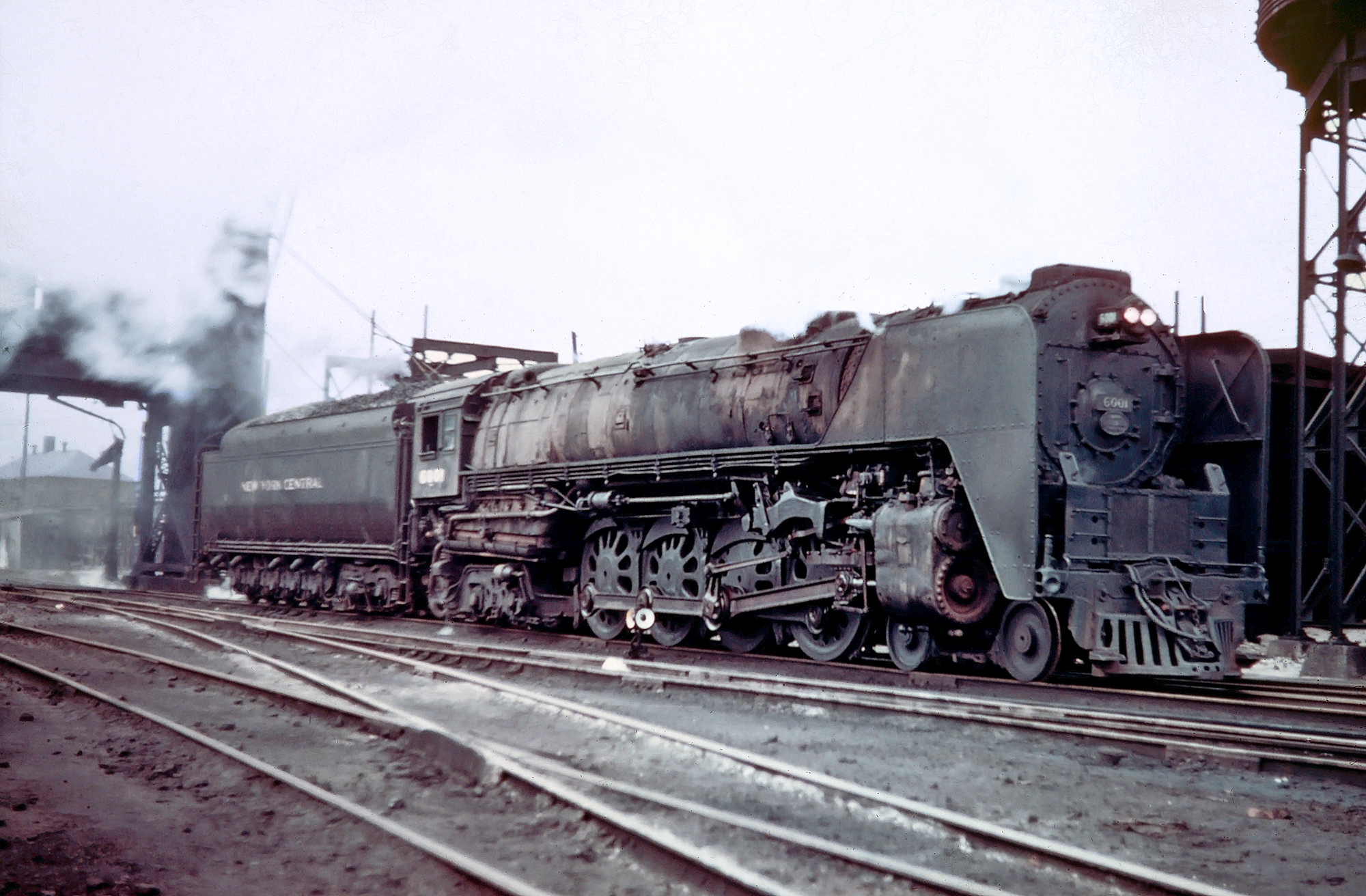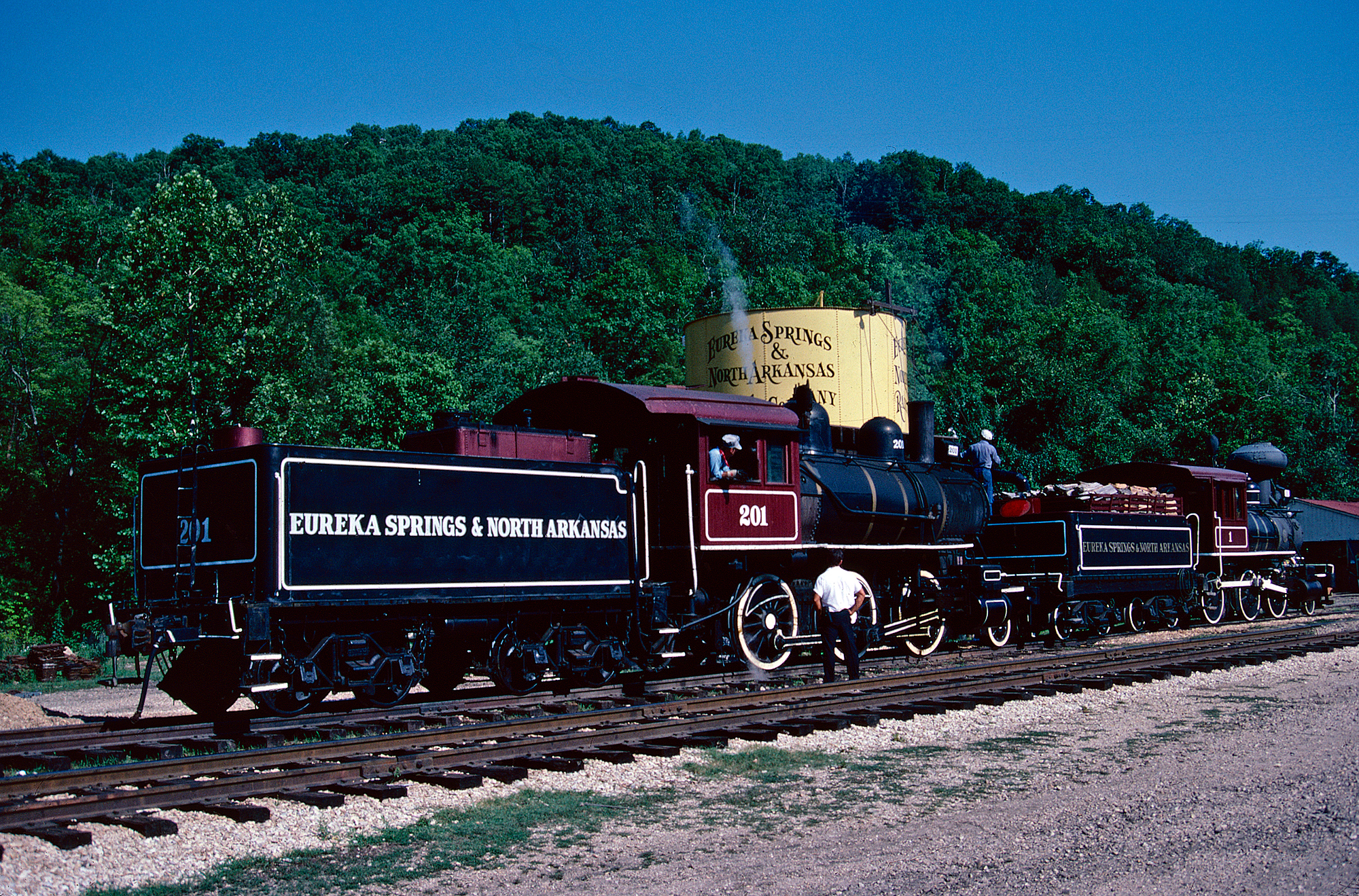NYC's 4-8-4 "Niagara" Locomotives: History, Specs, Photos
Last revised: February 27, 2025
By: Adam Burns
New York Central's 4-8-4 class, affectionately nicknamed "Niagara," represent a pinnacle of steam locomotive design and engineering.
These fine locomotives were significant in their contribution to railroading history, marrying power with the finesse essential for handling fast passenger services.
While other modern 4-8-4s may have surpassed the S-1B in terms of weight and tractive effort, few could rival this pinnacle of locomotive engineering in steam generation, horsepower, speed, and capability.
A revolutionary boiler design eliminated the steam dome, maximizing boiler size within the constraints of the New York Central loading gauge.
This enlarged boiler necessitated some unique adaptations: the sandbox was recessed into the boiler top, the smokestack was unusually short, and the air reservoirs were integrated into the massive frame.
Additional innovations included positioning the turbo generator below the colossal firebox and mounting the bell on the pilot beam.
The S-1B's design also deviated from the standard NYC appearance, featuring an unconventional smokebox front and a headlight positioned above the boiler centerline.
These technological marvels were complemented by enormous PT tenders with a 4-10-0 (centipede) wheel arrangement, reinforcing the S-1B's reputation as a masterpiece of locomotive craftsmanship.
 One of the New York Central's magnificent 4-8-4 "Niagaras," #6001, is seen here in Chicago a few years before she was retired, circa 1953. One of the very best examples of this wheel arrangement put into service, sadly none of these fabulous locomotives were preserved. American-Rails.com collection.
One of the New York Central's magnificent 4-8-4 "Niagaras," #6001, is seen here in Chicago a few years before she was retired, circa 1953. One of the very best examples of this wheel arrangement put into service, sadly none of these fabulous locomotives were preserved. American-Rails.com collection.Development and Background
Post-World War II, the New York Central Railroad faced a surge in passenger traffic, necessitating a robust solution.
Paul Kiefer, the Chief Mechanical Engineer of Motive Power and Rolling Stock, envisioned a new class of locomotives that surpassed the capabilities of the existing 4-6-4 Hudsons and the recently built L-4 Class 4-8-2s.
The challenge was clear: create a locomotive with a larger boiler capacity, increased adhesive weight, and greater tractive effort. Thus, the development of the "Niagara" class began as a means to upgrade the fleet with locomotives capable of greater power outputs while maintaining or improving efficiency.
The Niagaras would ultimately boast a 30% increase in tractive effort and 25% more grate area, a formidable 6000 horsepower rating, and roller bearings on all axles, coupling rods, and connecting rods.
The American Locomotive Company (Alco) was entrusted with this ambitious project. Such was the confidence of the New York Central in this design that they preemptively placed an additional order for 26 similar locomotives even before the prototype's delivery.
These subsequent locomotives, scheduled for late 1945 and early 1946, featured 79" drivers as opposed to the initial prototype's 75" drivers.
Alco delivered the pioneering Class S-1A 4-8-4 in 1945. Aligning with the design's 6000 horsepower objective, this groundbreaking locomotive was assigned the road number 6000.
Construction and Classes
The NYC "Niagara" class steam locomotives were constructed by the American Locomotive Company (ALCO) between 1945 and 1946. A total of 27 locomotives were built, including an experimental variant. They were designated under the NYC Class S, specifically the class S-1 to S-2.
Key Construction Information:
- Builder: American Locomotive Company (ALCO)
- Production Years: 1945–1946
- Number Built: 27 (26 production locomotives, 1 experimental)
The Niagara class was designed to embody high-speed capabilities while ensuring optimal fuel and water efficiency—a challenge for traditional steam locomotives. These locomotives featured advanced engineering innovations of their time.
| Class | Road Numbers | Year Built | Builder |
|---|---|---|---|
| S-1a | 6000 | 1945 | Alco |
| S-1b | 6001-6019 | October-December 1945 | Alco |
| S-1b | 6020-6022 | January, 1946 | Alco |
| S-1b | 6023-6025 | April, 1946 | Alco |
| S-2a | 5500 | June, 1946 | Alco |
General Specifications:
- **Configuration:** 4-8-4
- **Driver Diameter:** 75 inches (1,905 mm)
- **Locomotive Weight:** Approximately 471,000 pounds
- **Tender Weight:** 337,000 pounds
- **Combined Weight:** 808,000 pounds
- **Fuel Type:** Coal
- **Boiler Pressure:** 275 psi (1.9 MPa)
- **Cylinder Size:** 25.5 inches × 32 inches (648 mm × 813 mm)
- **Tractive Effort:** 62,333 pounds-force (273.8 kN)
- **Total Heating Surface:** 5,353 square feet (497.3 m²)
- **Superheater Area:** 1,785 square feet (165.8 m²)
- **Firebox Area:** 462 square feet (42.9 m²)
Performance
The Niagaras excelled in high-speed performances, capable of maintaining sustained speeds of 100 mph (160 km/h) while hauling heavy passenger trains. The design emphasized enhanced exhaust steam flow and reduced back pressure to maintain steam efficiency at these high speeds.
Design Features
1. **Boiler Design:** The boiler design incorporated a large firebox and combustion chamber, promoting efficient fuel combustion. This contributed to the significant steam capacity required for fast and heavy services.
2. **Feedwater Heater:** To enhance thermal efficiency, the Niagaras were equipped with feedwater heaters, which pre-heated the water before it entered the boiler, reducing the fuel consumption needed to generate steam.
3. **Berkshire Frame:** The frame design derived principles from the "Berkshire" 2-8-4 designs, known for their strength and durability, ensuring the Niagaras could handle the stresses of high-speed operation.
4. **Roller Bearings:** To reduce friction and maintenance, roller bearings were used extensively in various parts of the locomotive, including driving wheels and axles.
5. **Advanced Valve Gear:** Employing the Baker valve gear allowed precise steam distribution, contributing to the overall efficiency and power of the locomotives.
6. **Cylindrical Tender:** The Niagaras were paired with cylindrical tenders that were devised to streamline and improve the overall profile, reducing air resistance and improving fuel efficiency.
Operational History
The Niagaras were predominantly used for high-speed passenger service, operating famed trains like the 20th Century Limited and the Empire State Express.
Their ability to perform exceptional feats made them the pride of the NYC passenger services. They were capable of hauling heavy passenger trains across long distances, requiring fewer stops, which was a significant improvement over older steam locomotives.
Nevertheless, despite their impressive specifications and capabilities, the Niagaras faced an operational environment that was rapidly shifting towards diesel locomotives.
The diesel engines gradually demonstrated advantages in terms of lower operational costs, reduced maintenance, and the ability to run without the extensive support facilities required by steam locomotives.
Downfall and Legacy
The late 1940s and early 1950s marked the decline of steam locomotives across the United States, and the Niagara class was not immune to this trend.
In addition, the Niagaras' arrival coincided with new E7 passenger diesels, and then F3s and F7s shortly thereafter. These locomotives offered easier servicing and quicker turnaround times, making them more economical and efficient than their steam counterparts.
As the New York Central continued to invest in diesels, the 4-8-4s were reassigned from their premier duties. By 1950, these impressive steam engines were relegated to less critical tasks.
Diesel-electrics increasingly replaced steam as they became more efficient and economically viable. This led to the early retirement of the Niagaras.
The NYC prioritized dieselizing its easternmost divisions, and by 1953, the remaining 4-8-4s found themselves relocated to Ohio and Indiana. Here, they participated in some passenger service but were predominantly utilized for freight duties.
Their substantial weight confined them to a limited number of routes on the former Big Four lines. These locomotives, designed for high-speed performance, were not ideally suited for the low-speed tasks they were now assigned.
Nevertheless, they continued to operate until 1955-1956, when their equipment trusts expired, and the railroad fully transitioned to diesel power.
By 1956, most were scrapped, despite their relatively recent introduction and groundbreaking design. Only in railroad memory and records do these engines continue to exist as symbols of the final and most powerful steam locomotives produced for the New York Central.
Importance and Technological Legacy
Although the operational lifespan of the Niagara was short-lived, their design innovations and performance left an indelible mark on steam locomotive development. They represented the zenith of steam locomotive technology and served as a bridge between the classic era of steam and the budding era of diesel-electrics.
The emphasis on high-efficiency steam production, advanced bearing technologies, and streamlined design influenced subsequent locomotive engineering and even preserved the esteem steam power held during the transition phase.
Conclusion
The Niagaras were unmistakably ahead of their time, combining power with innovative design features tailored for high-speed passenger service. Despite facing competition from the emerging diesel-electric technologies, their brief operational history was marked by exceptional performances and records.
Their legacy remains in railroad history as the final and perhaps the finest expression of American steam engineering, standing as a tribute to human ingenuity during a transformative period in railroading. The Niagaras symbolize the apex of steam power, occupying a permanent place in the pantheon of legendary locomotives.
Recent Articles
-
Arizona Railroad Museums: A Complete Guide
Apr 16, 25 01:17 PM
Learn about Arizona's rich history with railroads at one of several museums scattered throughout the state. More information about these organizations may be found here. -
Arkansas Railroad Museums: A Complete Guide
Apr 16, 25 12:59 PM
The state of Arkansas is home to a handful of small railroad museums. Learn more about these organizations here. -
Alabama Railroad Museums: A Complete Guide
Apr 16, 25 12:30 PM
Alabama, with its storied past and vibrant connection to the railroad industry, is home to several captivating railroad museums.

